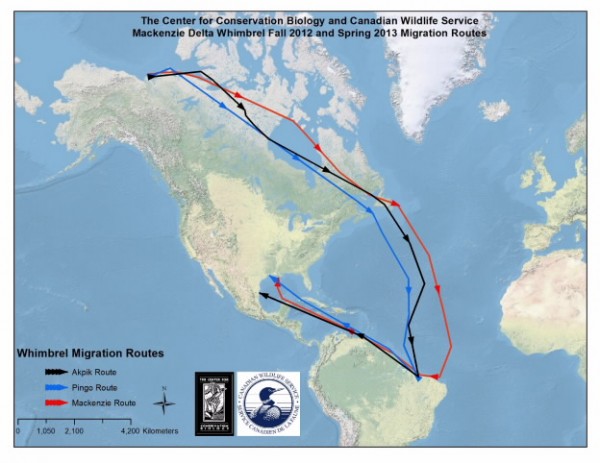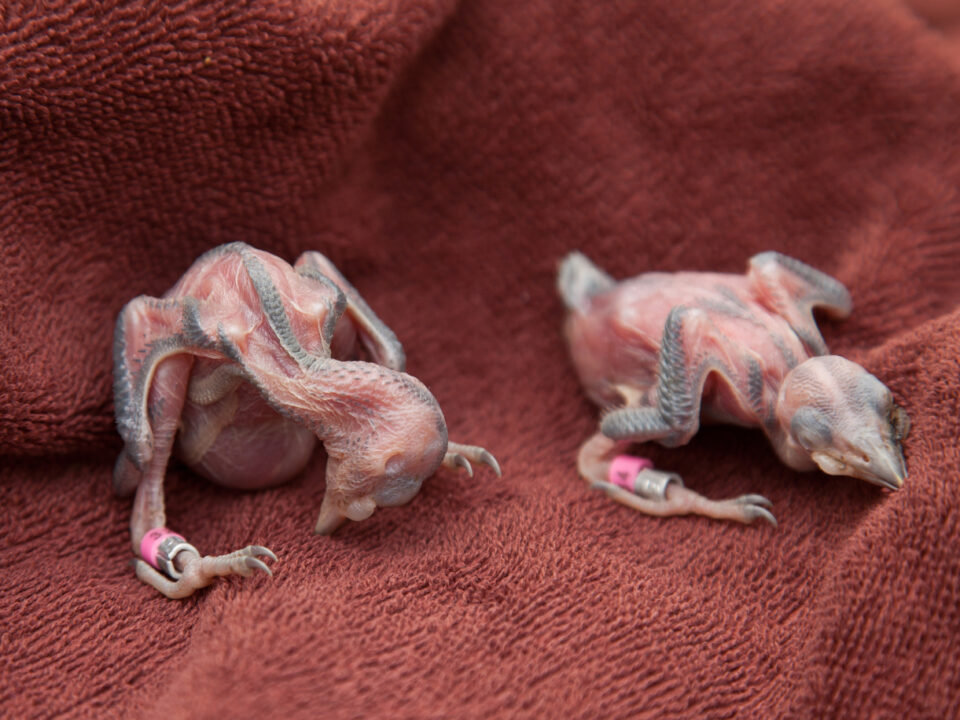Whimbrels complete 3rd leg of unknown loop migration route
Camellia Back at K&Q Landfill 4/20
April 21, 2013Camellia – Landfill to Landfill 4/24
April 24, 2013
(Williamsburg, VA)—Scientists at the Center for Conservation Biology have tracked 3 whimbrels from wintering areas on the coast of Brazil on a nonstop, 4,000 mile (6,400 kilometer) flight to the Gulf of Mexico. This flight represents the third leg of a previously unknown loop migration route and connects four widely scattered locations in the conservation of this declining species.
The three birds named Mackenzie (for the river where they breed), Akpik (named for the cloudberry that the birds feed on in the fall) and Pingo (named for an arctic formation caused by permafrost) left their wintering grounds near Sao Luis, Brazil between 9 and 13 April. The birds flew nonstop for 95 to 100 hours averaging 40 miles per hour (67 kilometers per hour) before reaching the Gulf of Mexico. Originally captured and marked on the breeding grounds along the Mackenzie River in far western Canada in June of 2012, the birds took a bold fall migration route flying 2,800 miles (4,500 kilometers) to the east coast of Canada in mid-July to stage for 2 weeks before embarking on a marathon 4,300-mile (6,900-kilometer) flight out over the open ocean to the northern coast of South America. All three birds have spent just over 7 months in the extensive tidal system of the Gulf of Maranhao before initiating their migration north.

Map of migration route for 3 whimbrels marked on breeding ground in western Canada. Recent flight from Brazil to Gulf of Mexico was previously undocumented. Photo by CCB.
All three birds are currently staging in different locations. Akpik is staging in Laguna Madre within the state of Tamaulipas, Mexico a site known to be a critical wintering area for the closely related long-billed curlew. Mackenzie is near the Demieres Isles in southern Louisiana. Pingo is in and around Anahuac National Wildlife Refuge south of Houston, Texas the site of a recently discovered spring staging area of hemispheric importance to whimbrels. Understanding the connectivity of this site to breeding areas has become a high priority for the research community. The bird appears to be using farm fields that have been managed over the winter for migrating shorebirds.
Mackenzie, Akpik and Pingo, all from the same breeding location, have now linked sites in far-flung, unexpected regions in their orb of conservation. Important in their own right, each of these sites must be considered collectively for conservation efforts to be effective. Mackenzie, the bird fitted with the recycled transmitter of Machi (a bird shot on Guadeloupe in September of 2011) is now staging in the heart of the area impacted by the Deep Horizon Oil Spill. The spill began on 20 April, during the time of whimbrel staging in 2010. Such events highlight the fragility of conservation networks and the importance of locations and cultures working together toward common goals. Through these birds we now know that an oil spill in the Gulf of Mexico may impact a breeding population on the Mackenzie River, or a staging area in Nova Scotia, or a wintering area around the mouth of the Amazon. Understanding these linkages is a critical step in protecting these networks and the species that depend on them.

Fletcher Smith with Akpik on breeding ground in the Canadian Arctic. This bird is now staging in Laguna Madre. Photo by CCB.
The three whimbrels are part of a larger project that has included 20 additional birds that have been tracked to better understand migratory pathways and locations that are critical for this declining species. The study has tracked whimbrels for more than 200,000 miles (322,000 kilometers) since 2008. The broader tracking project is a collaborative effort between The Center for Conservation Biology, The Canadian Wildlife Service, The Nature Conservancy, The U.S. Fish and Wildlife Service, Georgia Department of Natural Resources, the Virginia Coastal Zone Management Program, and Manomet Center for Conservation Sciences.
Follow the migration routes of these whimbrels and others at the Seaturtle.org Wildlife Tracking page.
Written by
Bryan Watts, bdwatt@wm.edu, (757) 221-2247 &
Fletcher Smith, fmsmit@wm.edu, (757) 221-1617
April 23, 2013
Related posts
Adult female from Elkins Chimney territory. Both the female and male were lost from this site between 2024 and 2025 nesting seasons and were not replaced. This territory has been occupied since 1995. Five territories were vacated between 2024 and 2025 along the Delmarva Peninsula in VA. Photo by Bryan Watts




2 Comments
Each year we get up to about 300 whimbrels, as there were last Friday, around Grand Bay in far SW Alabama. They too seem to to be on the known migration tracks.
Whimbrels stage on the Upper Texas Coast in impressive numbers in the spring. These birds often congregate in recently inundated rice fields and in fields flooded for crawfish production. Examples of high counts include the following: 2 May 1992 (1,017), 9 May 1992 (1,067), 27 Apr 1994 (2,645).
While the connection to Mackenzie may have been unknown, the staging of whimbrels along the upper Texas coast has been known for decades.
Eubanks, Ted L., B. Behrstock, and R. Weeks. 2006. The Birdlife of Houston, Galveston, and the Upper Texas Coast. College Station: Texas A&M Press. 287 pp.